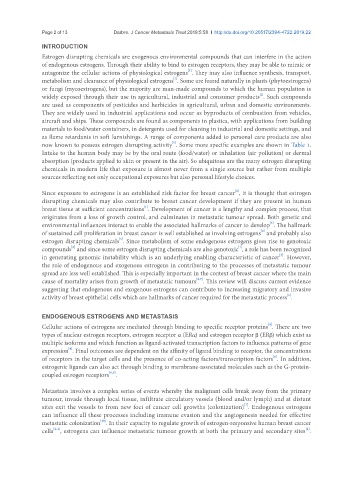Page 389 - Read Online
P. 389
Page 2 of 13 Darbre. J Cancer Metastasis Treat 2019;5:58 I http://dx.doi.org/10.20517/2394-4722.2019.22
INTRODUCTION
Estrogen disrupting chemicals are exogenous environmental compounds that can interfere in the action
of endogenous estrogens. Through their ability to bind to estrogen receptors, they may be able to mimic or
[1]
antagonize the cellular actions of physiological estrogens . They may also influence synthesis, transport,
[1]
metabolism and clearance of physiological estrogens . Some are found naturally in plants (phytoestrogens)
or fungi (mycoestrogens), but the majority are man-made compounds to which the human population is
[1]
widely exposed through their use in agricultural, industrial and consumer products . Such compounds
are used as components of pesticides and herbicides in agricultural, urban and domestic environments.
They are widely used in industrial applications and occur as byproducts of combustion from vehicles,
aircraft and ships. These compounds are found as components in plastics, with applications from building
materials to food/water containers, in detergents used for cleaning in industrial and domestic settings, and
as flame retardants in soft furnishings. A range of components added to personal care products are also
[1]
now known to possess estrogen disrupting activity . Some more specific examples are shown in Table 1.
Intake to the human body may be by the oral route (food/water) or inhalation (air pollution) or dermal
absorption (products applied to skin or present in the air). So ubiquitous are the many estrogen disrupting
chemicals in modern life that exposure is almost never from a single source but rather from multiple
sources reflecting not only occupational exposures but also personal lifestyle choices.
Since exposure to estrogens is an established risk factor for breast cancer , it is thought that estrogen
[2]
disrupting chemicals may also contribute to breast cancer development if they are present in human
breast tissue at sufficient concentrations . Development of cancer is a lengthy and complex process, that
[1]
originates from a loss of growth control, and culminates in metastatic tumour spread. Both genetic and
[3]
environmental influences interact to enable the associated hallmarks of cancer to develop . The hallmark
[4]
of sustained cell proliferation in breast cancer is well established as involving estrogens and probably also
estrogen disrupting chemicals . Since metabolism of some endogenous estrogens gives rise to genotoxic
[5]
[1]
[6]
compounds and since some estrogen disrupting chemicals are also genotoxic , a role has been recognized
in generating genomic instability which is an underlying enabling characteristic of cancer . However,
[3]
the role of endogenous and exogenous estrogens in contributing to the processes of metastatic tumour
spread are less well established. This is especially important in the context of breast cancer where the main
[2,7]
cause of mortality arises from growth of metastatic tumours . This review will discuss current evidence
suggesting that endogenous and exogenous estrogens can contribute to increasing migratory and invasive
[3]
activity of breast epithelial cells which are hallmarks of cancer required for the metastatic process .
ENDOGENOUS ESTROGENS AND METASTASIS
[8]
Cellular actions of estrogens are mediated through binding to specific receptor proteins . There are two
types of nuclear estrogen receptors, estrogen receptor a (ERa) and estrogen receptor b (ERb) which exist as
multiple isoforms and which function as ligand-activated transcription factors to influence patterns of gene
[8]
expression . Final outcomes are dependent on the affinity of ligand binding to receptor, the concentrations
of receptors in the target cells and the presence of co-acting factors/transcription factors . In addition,
[8]
estrogenic ligands can also act through binding to membrane-associated molecules such as the G-protein-
coupled estrogen receptors .
[8,9]
Metastasis involves a complex series of events whereby the malignant cells break away from the primary
tumour, invade through local tissue, infiltrate circulatory vessels (blood and/or lymph) and at distant
sites exit the vessels to from new foci of cancer cell growths (colonization) . Endogenous estrogens
[7]
can influence all these processes including immune evasion and the angiogenesis needed for effective
[10]
metastatic colonization . In their capacity to regulate growth of estrogen-responsive human breast cancer
[2]
[2,4]
cells , estrogens can influence metastatic tumour growth at both the primary and secondary sites .

